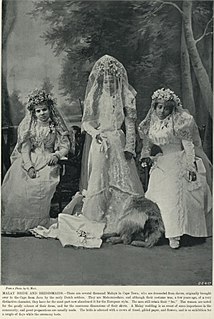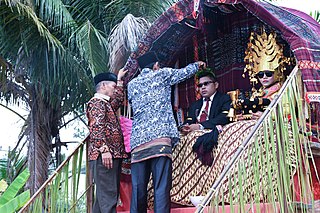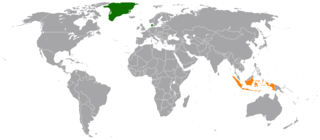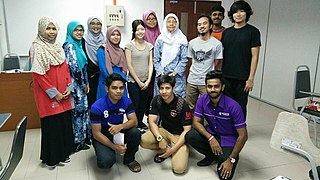Related Research Articles

Malays are an Austronesian ethnic group native to eastern Sumatra, the Malay Peninsula and coastal Borneo, as well as the smaller islands that lie between these locations — areas that are collectively known as the Malay world. These locations are today part of the countries of Malaysia, Indonesia, southern part of Thailand, Singapore and Brunei Darussalam.
Baybayin is a Philippine script. The script is an alphasyllabary belonging to the family of the Brahmic scripts. It was widely used in Luzon and other parts of the Philippines prior to and during the 16th and 17th centuries before being replaced by the Latin alphabet during the period of Spanish colonization. It was used in Tagalog and, to a lesser extent, Kapampangan speaking areas; its use spread to Ilokanos in the early 17th century. In the 19th and 20th centuries, baybayin survived and evolved into multiple forms—the Tagbanwa script of Palawan, and the Hanuno'o and Buhid scripts of Mindoro—and was used to create the constructed modern Kulitan script of the Kapampangan and the Ibalnan script of the Palawan tribe. Under the Unicode Standard and ISO 15924, the script is known as Tagalog.
Kawi or Old Javanese is the oldest attested phase of the Javanese language. It was spoken in the eastern part of what is now Central Java and the whole of East Java, Indonesia. As a literary language, Kawi was used across Java and on the islands of Madura, Bali and Lombok. It had a sizable vocabulary of Sanskrit loanwords but had not yet developed the formal krama language register, to be used with one's social superiors that is characteristic of modern Javanese.

Jawi is a writing system used for writing the Malay language and several other languages of Southeast Asia, such as Acehnese, Banjarese, Kerinci, Minangkabau, Tausūg, Maguindanao and Ternate. Jawi is based on the Arabic script, consisting of all of the original 28 Arabic letters, and five additional letters constructed to fit the phonemes native to Malay, and an additional phoneme used in foreign loanwords, but not found in Classical Arabic, which are ca, nga, pa, ga, va, and nya.

Nusantara is the Indonesian name of Maritime Southeast Asia. It is an Old Javanese term which literally means "outer islands". In Indonesia, it is generally taken to mean the Indonesian Archipelago. In the Malay world, the term has been adopted to mean the Malay Archipelago.
The Javanese script is one of Indonesia's traditional scripts developed on the island of Java. The script is primarily used to write the Javanese language, but in the course of its development has also been used to write several other regional languages such as Sundanese, Madurese, and Sasak; the lingua franca of the region, Malay; as well as the historical languages Kawi and Sanskrit. Javanese script was actively used by the Javanese people for writing day-to-day and literary texts from at least the mid-15th century CE until the mid-20th century CE, before its function was gradually supplanted by the Latin alphabet. Today the script is taught in DI Yogyakarta, Central Java, and the East Java Province as part of the local curriculum, but with very limited function in everyday use.

Cape Malays also known as Cape Muslims or Malays, are a Muslim community or ethnic group in South Africa. They are the descendants of enslaved and free Muslims from different parts of the world who lived at the Cape during Dutch and British rule.

Pagaruyung was the seat of the Minangkabau kings of Western Sumatra, though little is known about it. Modern Pagaruyung is a village in Tanjung Emas subdistrict, Tanah Datar regency, located near the town of Batusangkar, Indonesia.

Malay was first used in the first millennia known as Old Malay, a part of the Austronesian language family. Over a period of two millennia, Malay has undergone various stages of development that derived from different layers of foreign influences through international trade, religious expansion, colonisation and developments of new socio-political trends. The oldest form of Malay is descended from the Proto-Malayo-Polynesian language spoken by the earliest Austronesian settlers in Southeast Asia. This form would later evolve into Old Malay when Indian cultures and religions began penetrating the region, most probably using the Kawi and Rencong scripts, some linguistic researchers say. Old Malay contained some terms that exist today, but are unintelligible to modern speakers, while the modern language is already largely recognisable in written Classical Malay of 1303 CE.

The Mandailing is a traditional one of sub-ethnic cultural group of Batak people from North Sumatera in Indonesia. They are found mainly in the northern section of the island of Sumatra in Indonesia. They came under the domination of the Kaum Padri who ruled the Minangkabau of Tanah Datar. As a result, the Mandailing were influenced by Muslim culture and converted to Islam. There are also a group of Mandailing in Malaysia, especially in the states of Selangor and Perak. They are closely related to the Angkola.
Islam is the most widely practised religion in Southeast Asia, numbering approximately 240 million adherents which translate to about 42% of the entire population, with majorities in Brunei, Indonesia and Malaysia as well Southern Thailand and parts of Mindanao in the Philippines respectively. Significant minorities are located in the other Southeast Asian states. Most Muslims in Southeast Asia are Sunni and follow the Shafi`i school of fiqh, or religious law. It is the official religion in Malaysia and Brunei while it is one of the six official faiths in Indonesia.
The Lontara script, also known as the Bugis script, Bugis-Makassar script, or Urupu Sulapa’ Eppa’ "four-cornered letters", is one of Indonesia's traditional scripts developed in the South Sulawesi region. The script is primarily used to write the Buginese language, followed by Makassarese and Mandar. Closely related variants of Lontara are also used to write several languages outside of Sulawesi such as Bima, Ende, and Sumbawa. The script was actively used by several South Sulawesi societies for day-to-day and literary texts from at least mid-15th Century CE until the mid-20th Century CE, before its function was gradually supplanted by the Latin alphabet. Today the script is taught in South Sulawesi Province as part of the local curriculum, but with very limited usage in everyday life.
Merle Calvin Ricklefs was an American-born Australian scholar of the history and current affairs of Indonesia.

The Islamic Arts Museum Malaysia is a museum in Kuala Lumpur, Malaysia. It was officially opened on 12 December 1998. The museum is the largest museum of Islamic arts in South East Asia with more than seven thousands artifacts from the Islamic world.

Pegon is a modified Arabic script used to write the Javanese, Sundanese, and Madurese languages, as an alternative to the Latin script or the Javanese script and the old Sundanese script. In particular, it was used for religious (Islamic) writing and poetry from the fifteenth century, particularly in writing commentaries of the Qur'an. Pegon includes symbols for sounds that are not present in Modern Standard Arabic. Pegon has been studied far less than its Jawi counterpart which is used for Malay, Acehnese and Minangkabau.

Denmark and Indonesia established diplomatic relations in 1974. Denmark has an embassy in Jakarta, and Indonesia has an embassy in Copenhagen. Bilateral relations are strong, as well as the humanitarian response to the December 2004 Indian Ocean tsunami, which claimed the lives of 45 Danes. In 2015, after focusing on China and South Korea, Denmark is gearing up to enhance its relations with Indonesia, hoping that it will help Denmark to build strong ties with the whole Southeast Asian region.

Bernard Arps, Professor of Indonesian and Javanese Language and Culture at Leiden University, Netherlands, was born in 1961 in Leiden.

Zailan Moris is a Malaysian scholar of Islamic philosophy and former professor of the School of Humanities at the University Sains Malaysia. Her main interests are Islamic philosophy, comparative religion and Sufism.

The Endangered Archives Programme (EAP) is a funding programme and digital archive run by the British Library in London. It has the purpose of preserving cultural heritage where resources may be limited. Each year EAP awards grants to researchers to identify and preserve culturally important archives by digitising them in situ. The original archival material does not leave the country of origin, and projects often incorporate local training and career development. EAP focuses on material created before the mid twentieth century.
The Makasar script, also known as Ukiri' Jangang-jangang or Old Makasar script, is a historical Indonesian Writing system that was used in South Sulawesi to write the Makassarese language between the 17th and 19th centuries until it was supplanted by the Lontara Bugis script.
References
- 1 2 3 "Gallop, Dr Annabel Teh, (born 5 Aug. 1961), Head, Southeast Asia Section, British Library, since 1999". WHO'S WHO & WHO WAS WHO. 2020. doi:10.1093/ww/9780199540884.013.U293379. ISBN 978-0-19-954088-4 . Retrieved 2021-08-06.
- ↑ "Annabel Teh Gallop, Lead Curator, Southeast Asia". The British Library. Retrieved 2021-03-29.
- ↑ "Dr Annabel Teh Gallop FBA". The British Academy. Retrieved 2021-03-29.